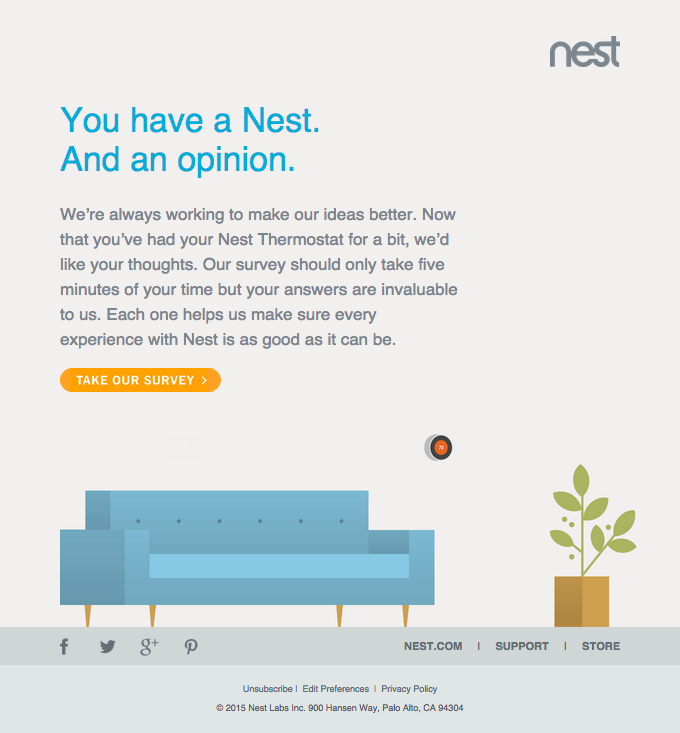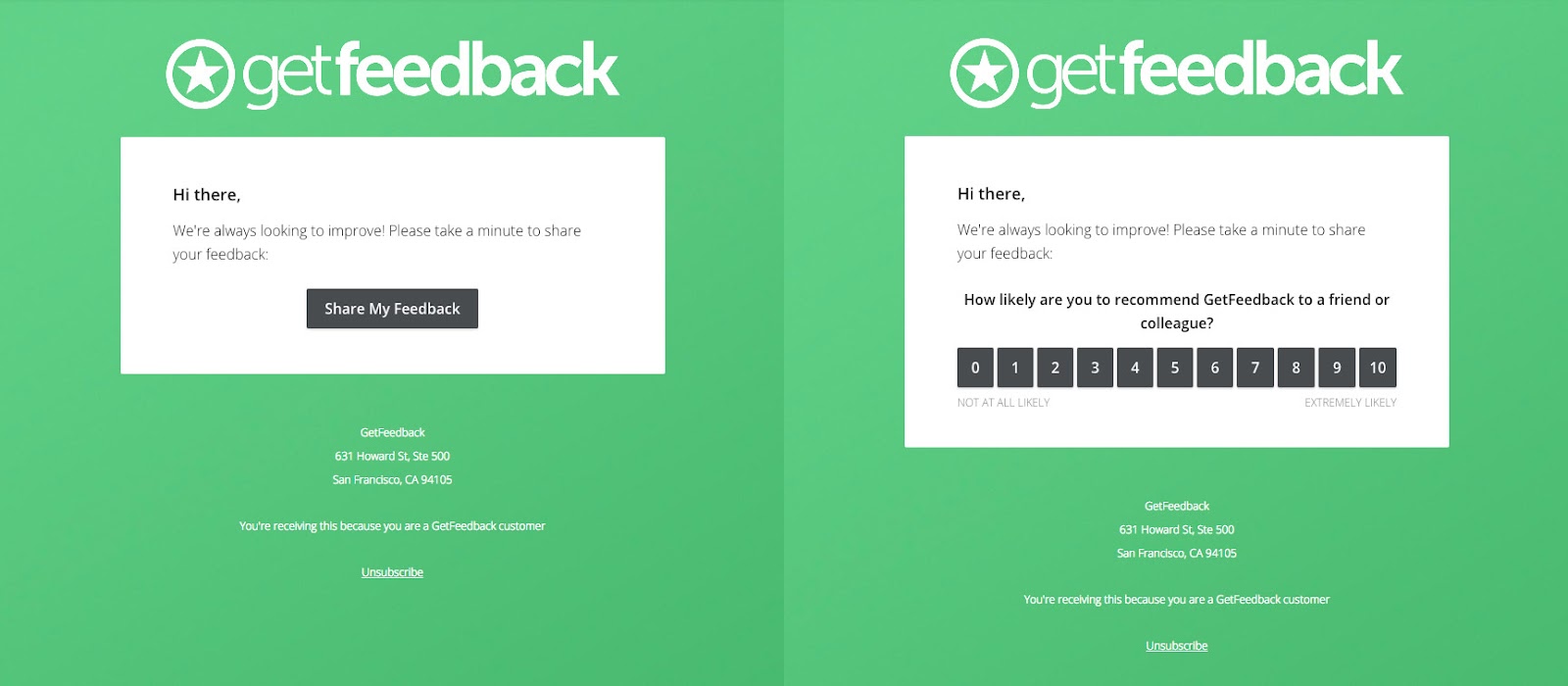
Many people overlook one of the most important parts of your feedback surveys. That’s the customer satisfaction survey introduction, which can make or break your feedback campaign.
An introduction allows you to hook your guests and persuade them to open your survey. Without one, you likely won’t get as many responses.
In this guide, you’ll learn how to write a survey introduction that leads to soaring response rates.
Why does your customer satisfaction survey intro matter?
How to write a survey introduction
7 actionable tips for writing survey intros that get more responses
- 1. Leave the introduction for last
- 2. Remind guests why your survey is important
- 3. Use a conversational tone
- 4. Keep it short
- 5. Embed a question in your email
- 6. Add your logo to the top of your intro
- 7. Always thank your respondents for participating
Why does your customer satisfaction survey intro matter?
Many successful feedback surveys work because the introduction is engaging enough to convince customers to complete them.
Let’s face it: Not many people love completing a survey, especially if they’re getting nothing in return. Unless you plan on offering a reward that’s tough to say no to, your introduction is your chance to hook the reader in.
It’s the first thing your customers will see before deciding whether or not to start the survey. The survey intro allows you to tell them who you are and why you’re asking them for their feedback. Instead of implicitly asking guests to rate their experience, you’ll tell them how valuable their opinions are.
More so, you’ll show them that their responses have had a true impact on your company in the past.
A well-written intro can increase your survey response rates. The more feedback you receive the better you’ll understand how guests are feeling about your attraction.
How to write a survey introduction
Before your guests agree to answer your survey, they’ll want to know who’s sending it and what you plan to do with their answers. In your introduction, you should explain to guests why this survey won’t be a waste of their time.
Every great survey introduction should specifically answer the following:
- Who you are
- Why you’re asking for feedback
- How the feedback will be used
- How much time the survey will take
- Any relevant instructions
Travel companies can learn a thing or two about this from eCommerce brands, which are often quizzing their customers about recent purchases. Let’s take a look at how Nest, a company that sells smart thermostats, asks its customers for feedback.

First, the company catches the reader’s attention with a witty title: “You have a Nest. And an opinion.” Right off the bat, the customer will know that they’re receiving this survey because they’ve previously purchased a Nest thermostat.
The company then shares the reason behind the survey by saying, “We’re always working to make our ideas better.”
In the next couple of lines, Nest reassures the reader that the survey will only take five minutes to complete and again reiterates how much the company values customer feedback.
Nest does an excellent job persuading the reader to complete the survey by stressing how much the team values their customers’ opinions.
Now, let’s see how an attraction could similarly approach its guests for feedback.
To find out how guests feel about their visit, a museum might start its customer feedback survey in the following way:
Hi Carla!
Thank you for visiting [Museum Name]! We hope you enjoyed your time roaming through our galleries.
We’re always looking for ways to improve and innovate our experience — and visitors like you can help us do that. We’d love to hear more about your visit. If you can spare a quick 5 minutes to answer a few questions about your experience, we’d greatly appreciate it!
We’d love to know what you thought about our new exhibits and how easy it was for you to navigate through our galleries. We promise to use your valuable feedback to continuously improve our visitor experience.
Thank you in advance for your time, and we look forward to welcoming you again!
The Team over at [Museum Name]
This introduction is conversational yet short and to the point. It successfully delivers the message that you’re looking for customer feedback to improve your overall guest experience. Specifically, the introduction tells the reader that they’ll be answering questions related to the new exhibits and the ease of getting around the museum.
The reader knows it’ll take just five minutes to complete the survey and that their feedback will help improve the experience — and hopefully, that’s persuading enough to have them hit the “start survey” button.
7 actionable tips for writing survey intros that get more responses
As you’re putting your survey introduction together, consider these seven tips to make it even better.
1. Leave the introduction for last
Since the introduction is the first thing guests see before answering your survey, your instinct might be to write it first. Yet there’s a good reason why you shouldn’t.
Your introduction should be a summary of your survey. It’s much easier to summarize something once it’s already written. Your questions will determine the purpose of your survey and the kind of feedback you’re looking for. Once they’re written, you’ll have a better grasp of what guests can expect when they start your survey — as well as how long it takes to complete it.
2. Remind guests why your survey is important
The purpose of a survey introduction is to not only inform your guests but also to persuade them to hit that “start” button.
One way to do so is to explain why you’re surveying in the first place. Is it to improve your guest experience? Measure customer satisfaction with your customer service? Gauge how guests are feeling about a new exhibit, ride, or activity?
Then, clearly state the benefit for them in completing. Tell your guests that by answering just a few questions they can set themselves up for an even better experience with your company in the future.
Paint them a picture about a time when customer feedback made a difference for your company and future guests. Use this example to show them how valuable their feedback is to your company.
3. Use a conversational tone
A conversational and friendly introduction helps stave off the stigma that surveys are boring and that no one will read it.
Always refer to your guests by their first name and write an introduction that makes it feel like they’re talking to a friend. This way, they’ll feel like they’re helping out someone they care about — your brand — by responding.
4. Keep it short
Building on the previous tip, you don’t want to create a survey intro so long that your guests exit halfway through reading it. As you’ve seen in the examples above, your survey introduction should hit the main points — who, what, why — with just a few sentences. Remember that the point is to hook and convince the reader to provide you with feedback.
5. Embed a question in your email

Source: GetFeedback
GetFeedback found that embedding a question in the email sent to gather feedback led to 210% more responses. If you’re sending your survey via email, your introduction can appear at the top of the message.
Embedding a question such as “How likely are you to recommend our attraction to your friends and colleagues?” makes it easier for guests to respond because all they have to do is hit a number on the scale.
6. Add your logo to the top of your intro
An easy way to inform your guests who’s sending them a survey is to include a logo in your introduction. You can revisit the Nest example above to see how the company aligns its survey with its visual branding.
Seeing your logo frequently helps guests associate it with your company. This not only gives them comfort in knowing who the survey is coming from, but it also helps you boost your brand identity among existing customers.
7. Always thank your respondents for participating
The feedback you receive from your guests will likely shape the future of your attraction. When they complete your survey, make sure to express how thankful your company is for their time.
It can be as simple as including a quick thank you note:
“Thank you for taking the time to complete this survey! We’re consistently working to provide you with the best experience possible, and your feedback makes that possible. We look forward to welcoming you back soon!”
***
Guest feedback is what moves a tourism company forward and surveys are the ideal way to ask them how they’re feeling.
A well-written feedback survey introduction can send your response rates soaring. Make sure to refer back to these tips when creating your next survey.




